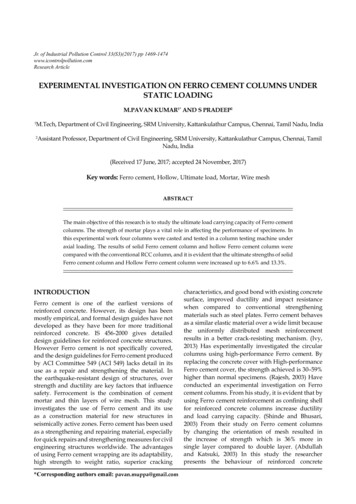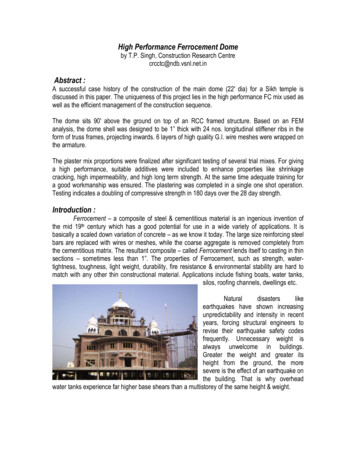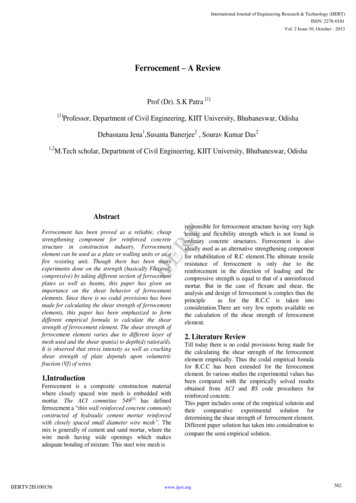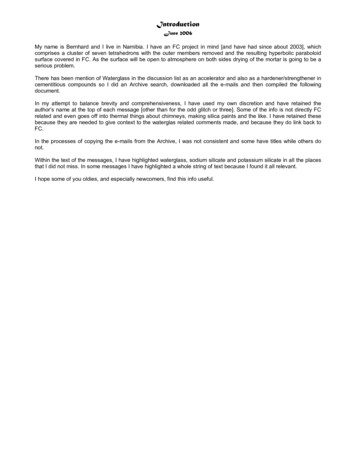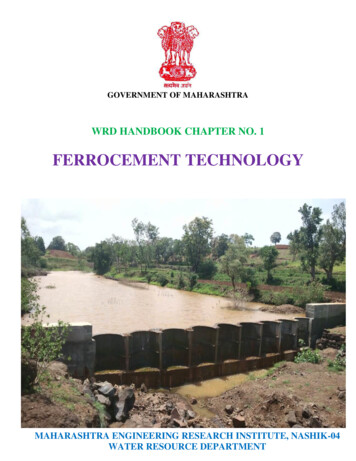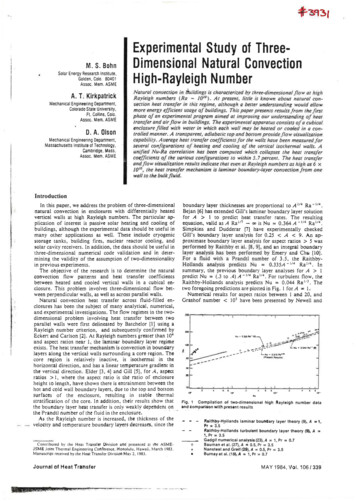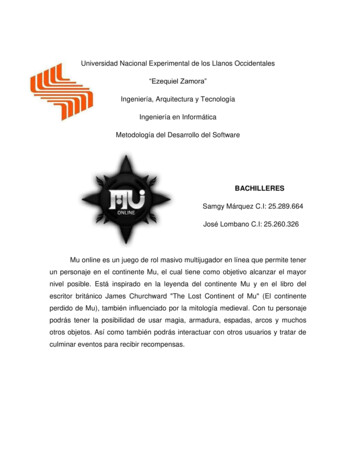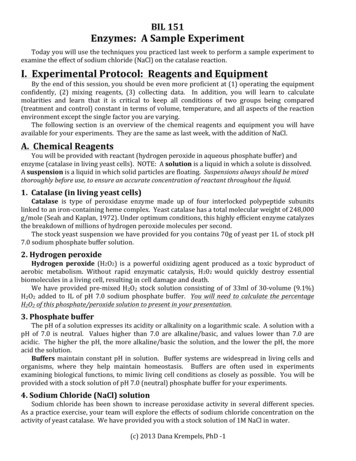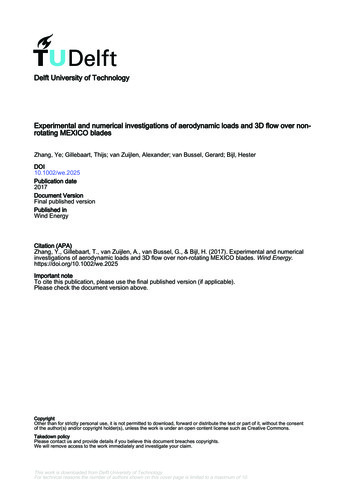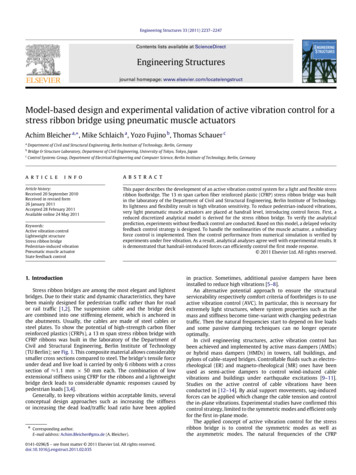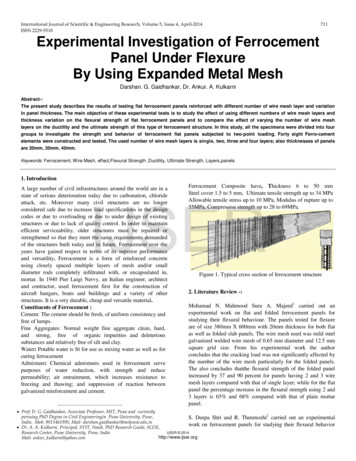
Transcription
International Journal of Scientific & Engineering Research, Volume 5, Issue 4, April-2014ISSN 2229-5518711Experimental Investigation of FerrocementPanel Under FlexureBy Using Expanded Metal MeshDarshan. G. Gaidhankar, Dr. Ankur. A. KulkarniAbstract-:The present study describes the results of testing flat ferrocement panels reinforced with different number of wire mesh layer and variationin panel thickness. The main objective of these experimental tests is to study the effect of using different numbers of wire mesh layers andthickness variation on the flexural strength of flat ferrocement panels and to compare the effect of varying the number of wire meshlayers on the ductility and the ultimate strength of this type of ferrocement structure. In this study, all the specimens were divided into fourgroups to investigate the strength and behavior of ferrocement flat panels subjected to two-point loading. Forty eight Ferro-cementelements were constructed and tested. The used number of wire mesh layers is single, two, three and four layers; also thicknesses of panelsare 20mm, 30mm, 40mm.Keywords: Ferrocement; Wire Mesh, effect,Flexural Strength ,Ductility, Ultimate Strength, Layers,panels1. IntroductionA large number of civil infrastructures around the world are in astate of serious deterioration today due to carbonation, chlorideattack, etc. Moreover many civil structures are no longerconsidered safe due to increase load specifications in the designcodes or due to overloading or due to under design of existingstructures or due to lack of quality control. In order to maintainefficient serviceability, older structures must be repaired orstrengthened so that they meet the same requirements demandedof the structures built today and in future. Ferrocement over theyears have gained respect in terms of its superior performanceand versatility. Ferrocement is a form of reinforced concreteusing closely spaced multiple layers of mesh and/or smalldiameter rods completely infiltrated with, or encapsulated in,mortar. In 1940 Pier Luigi Nervy, an Italian engineer, architectand contractor, used ferrocement first for the construction ofaircraft hangars, boats and buildings and a variety of otherstructures. It is a very durable, cheap and versatile material.Constituents of Ferrocement :Cement: The cement should be fresh, of uniform consistency andfree of lumps.Fine Aggregates: Normal weight fine aggregate clean, hard,and strong, free of organic impurities and deleterioussubstances and relatively free of silt and clay.Water: Potable water is fit for use as mixing water as well as forcuring ferrocementAdmixture: Chemical admixtures used in ferrocement servepurposes of water reduction, with strength and reducepermeability; air entrainment, which increases resistance tofreezing and thawing; and suppression of reaction betweengalvanized reinforcement and cement.Ferrocement Composite have, Thickness 6 to 50 mmSteel cover 1.5 to 5 mm, Ultimate tensile strength up to 34 MPaAllowable tensile stress up to 10 MPa, Modulus of rupture up to55MPa, Compressive strength up to 28 to ———Figure 1. Typical cross section of ferrocement structure2. Literature Review -:Mohamad N. Mahmood Sura A. Majeed1 carried out anexperimental work on flat and folded ferrocement panels forstudying their flexural behaviour. The panels tested for flexureare of size 380mm X 600mm with 20mm thickness for both flatas well as folded slab panels. The wire mesh used was mild steelgalvanized welded wire mesh of 0.65 mm diameter and 12.5 mmsquare grid size. From his experimental work the authorconcludes that the cracking load was not significantly affected bythe number of the wire mesh particularly for the folded panels.The also concludes thatthe flexural strength of the folded panelincreased by 37 and 90 percent for panels having 2 and 3 wiremesh layers compared with that of single layer; while for the flatpanel the percentage increase in the flexural strength using 2 and3 layers is 65% and 68% compared with that of plain mortarpanel. Prof. D. G. Gaidhankar, Associate Professor, MIT, Pune and currentlypersuing PhD Degree in Civil Engineeringin Pune University, Pune,S. Deepa Shri and R. Thenmozhi2 carried out an experimentalIndia. Mob. 9011461995, Mail- darshan.gaidhankar@mitpune.edu.inwork on ferrocement panels for studying their flexural behavior Dr. A. A. Kulkarni, Principal, SVIT, Nasik, PhD Research Guide, SCOE,IJSER 2014Research Center, Pune University, Pune, Indiahttp://www.ijser.orgMail- ankur kulkarni@yahoo.com
International Journal of Scientific & Engineering Research, Volume 5, Issue 4, April-2014ISSN 2229-5518by using polypropylene fiber. Silica fume is added to reduce thedosage of chemical admixtures needed to get required slump. It iswell known that addition of fiber will generally improve theductility, toughness, flexural strength and reduce the deflection ofcementitious materials. In the present study, polypropylene fiberis added to the matrix and the dosage of fiber is taken as 0.3% byweight of cementitious materials. Weld mesh is arranged indifferent layers in ferrocement slab instead of reinforcement.Weld mesh of size 590 mm X 290 mm with grid size 20 mm X 20mm and 1.2 mm dia. skeleton reinforcement is used for casting offerrocement slabs. The slab panel size was 700mm X 300mm X25mm and 30mm. The authors conclude that the load carryingcapacity of SCC ferrocement slab panel with 0.3% fiber is largercompared to without fiber, delayed the first crack load, yield loadand ultimate load compared to without fibers and there is anincrease in strength with the increase of slab thickness.Chee Ban Cheah and Mahyuddin Ramli3 carried out anexperimental work on HCWA ( High Calcium Wood Ash) – DSF( Densified Silica Fume ) high strength ferrocement panels forstudying the flexural behaviour. Superplasticzer was used as awater reduction agent. A total of five layers of welded galvanisedsteel square mesh with a wire diameter of 1.05 mm and 13 mmspacing were provided as an internal reinforcement for eachfabricated ferrocement panel. The Portland cement binder waspartially replaced using HCWA at substitution levels of 0% 2%,4%, 6%, 8% and 10% by total binder weight. Panel size used was350mm X 125mm X 30mm for testing. From the experimentalwork the authors concludes that the use of HCWA at variouslevels of cement replacement up to 6% by total binder weightenhances the bulk density, compressive strength, flexural strengthand Young’s modulus of elasticity of mortar. Also concludes thatthere is a high tendency for thin ferrocement panels to fail in thepure bending mode upon being subjected to a flexural load.712flyash was used as a partial replacement of cement by weight.Superplasticizer was also used as a water reduction agent. Thegalvanized chicken wire mesh was used as a reinforcement. Fromthe flexure study parameters such as first crack load, ultimateload, maximum deflection, and crack pattern were observed.From the experimental work the authors concludes thatFerrocement panels with chicken mesh exhibit linear elasticbehaviour up to the maximum load irrespective of the volumefraction of mesh reinforcement used. The authors also concludesthat there is an increase in the load carrying capacity of theferrocement panels with the increase in the volume fraction of themesh reinforcement.3. Objective of experimental study –The main objective of this experimental work is to study thebehavior of ferrocement panels under flexural loading in whichexpanded metal mesh has been used as a reinforcement. Thevarious parameters considered in this study are as follows -:a. Effect of number of mesh layers on the flexural strength of slabpanels.b. Effect of panel thickness on the flexural strength of slab panels.c.Effect of volume fraction on the flexural strength of slab panels.IJSERFahrizal Zulkarnain and Mohd. Zailan Suleiman4 carried out anexperimental work on ferrocement panels to study load anddeflection characteristics, moments, crack widths, crack spacing,and the number of cracks when subjected to static flexure. Thesize of the test specimen was 125 mm x 350 mm x 30 mm,reinforced with 3 layer of square welded mesh of 1.0 mmdiameter with opening of 12.0 mm x 12.0 mm. Three differentpolymer modification systems was employed in this study,namely styrene butadiene rubber latex (SBR), natural rubber latex(NR) and epoxy resin (ER), in their ability to increase the bondstrength between mortar and reinforcement. The authorsconcludes that the results show that polymer modification hasimproved the mechanical properties of cement mortars,particularly their flexural strength. Also concludes that the firstcrack load of the polymer-modified and unmodified ferrocementsshows higher predicted values than that of the experimental at 30days of curing.Experimental Work -:The experimental program includes preparing and testing of fortyeight ferrocement slab panels under two-point loading. Theprimary variables were the thickness of panels and number oflayers of meshes. The materials used for the experimental workwas as given below -:Cement – Ordinary Portland Cement, Sand -:Passing through 2.36mm I. S. Sieve, Crushed Sand -: Locally availableWater – Ordinary Drinking Water, Mesh Used – Expanded MetalMesh of 15mm X 30mm opening and 1.8 mm thickness.Mix Proportion Used -:W/c Ratio : Cement : Sand : Crushed Sand0.4:1: 1 :1Table 1.Comp. test results for cube at the end of 28 daysSr.sectionalLoad atComp.AverageNo.AreaFailureStrengthComp. Strength22( mm )( N)(N/mm )170 X 7022000044.89270 X 7021000042.85370 X 7022000044.89(N/mm2)44.40Table 2.Details of panels tested under flexure with notations -:5K. Sasiekalaa and R. Malathy carried out an experimental workfor studying flexural behaviour of ferrocement panels. The size ofthe slab panel was 500mm x150mm x 25mm. Silica fume andDimension ofpanels(mm)550x200x20IJSER 2014http://www.ijser.orgDesignationE1E2E3Number ofpanels030303Numberof layers020304
International Journal of Scientific & Engineering Research, Volume 5, Issue 4, April-2014ISSN 3030203040203047136080100Details of Flexural Strength -: The flexural strength test undertwo point loading was conducted on all the panels. During thetesting loads and the corresponding deflections are noted down0.150.290.40Firstcrackingload 80kg0.220.310.41Firstcrackingload 80kg0.230.370.38Firstcrackingload 60kgLoad vs DeflectionLoad (kg)150100E2150E22000.20.4Deflection (mm)0.6E23Table 4. Test results for Sample E2, Thickness of panels 20mm ; Number of Mesh layers tcrackingcrackingcrackingload 120kg load 100kg load 100kgIJSERFigure 2. SFD and BMD Distributionand are presented here in the forms of tables and graphs. Theflexural strenght was also calcuted and shown here.The bending strength was calculated by using the followingformula -:,Where:M: Bending Moment, (N.mm)y D/2, (mm)I: Moment of Inertia /12, ( 150Load (kg) Load vs Deflectiony100E3150E320-0.2)00.20.4Deflection (mm)0.6E33Figure 3. Flexural Strength TestTable 5. Test results for Sample E3, Thickness of panels 20mm ; Number of Mesh layers .04400.070.060.09600.090.100.134. Test Results -:Table 3. Test results for Sample E1, Thickness of panels 20mm ; Number of Mesh layers .05400.100.120.12IJSER 2014http://www.ijser.org
International Journal of Scientific & Engineering Research, Volume 5, Issue 4, April-2014ISSN .170.190.260.320.34Firstcrackingload 120kgFirstcrackingload 140kgFirstcrackingload 120kgLoad vs Deflection250200Load ection (mm)0.6Load vs DeflectionLoad (kg)200150100E4150E42E43000.20.4Deflection (mm)Table 7. Test results for Sample E5, Thickness of panels 30mm ; Number of Mesh layers 3Load(kg)Deflection(mm)IJSERTable 6. Test results for Sample E4, Thickness of panels 30mm ; Number of Mesh layers 200.250.260.290.330.350.360.38Firstcrackingload 80.380.40FirstFirstcrackingcrackingload load 0.280.300.340.350.36Firstcrackingload 220kgFirstcrackingload 200kgLoad vs Deflection300Load .300.310.320.330.35Firstcrackingload E3200IJSER 2014http://www.ijser.org0.2Deflection (mm)0.4E33
International Journal of Scientific & Engineering Research, Volume 5, Issue 4, April-2014ISSN 2229-5518Table 8. Test results for Sample E6, Thickness of panels 30mm ; Number of Mesh layers 0.270.290.310.32Firstcrackingload 230.270.290.310.32Firstcrackingload 170.200.220.240.250.260.280.300.33Load (kg)300250200Firstcrackingload 240kg0.4Table 9. Test results for Sample E7, Thickness of panels 40mm ; Number of Mesh layers .20.3Deflection 0.110.130.150.170.210.240.4Table 10. Test results for Sample E8, Thickness of panels 40mm ; Number of Mesh layers 2400.250.260.252
Cement: The cement should be fresh, of uniform consistency and free of lumps. Fine Aggregates: Normal weight fine aggregate clean, hard, and strong, free of organic impurities and deleterious substances and relatively free of silt and clay. Water: Potable water is fit for
